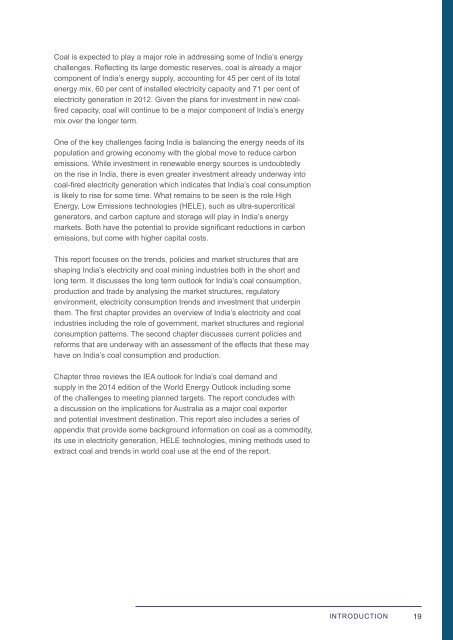Coal in India
1P05mmm
1P05mmm
You also want an ePaper? Increase the reach of your titles
YUMPU automatically turns print PDFs into web optimized ePapers that Google loves.
<strong>Coal</strong> is expected to play a major role <strong>in</strong> address<strong>in</strong>g some of <strong>India</strong>’s energychallenges. Reflect<strong>in</strong>g its large domestic reserves, coal is already a majorcomponent of <strong>India</strong>’s energy supply, account<strong>in</strong>g for 45 per cent of its totalenergy mix, 60 per cent of <strong>in</strong>stalled electricity capacity and 71 per cent ofelectricity generation <strong>in</strong> 2012. Given the plans for <strong>in</strong>vestment <strong>in</strong> new coalfiredcapacity, coal will cont<strong>in</strong>ue to be a major component of <strong>India</strong>’s energymix over the longer term.One of the key challenges fac<strong>in</strong>g <strong>India</strong> is balanc<strong>in</strong>g the energy needs of itspopulation and grow<strong>in</strong>g economy with the global move to reduce carbonemissions. While <strong>in</strong>vestment <strong>in</strong> renewable energy sources is undoubtedlyon the rise <strong>in</strong> <strong>India</strong>, there is even greater <strong>in</strong>vestment already underway <strong>in</strong>tocoal-fired electricity generation which <strong>in</strong>dicates that <strong>India</strong>’s coal consumptionis likely to rise for some time. What rema<strong>in</strong>s to be seen is the role HighEnergy, Low Emissions technologies (HELE), such as ultra-supercriticalgenerators, and carbon capture and storage will play <strong>in</strong> <strong>India</strong>’s energymarkets. Both have the potential to provide significant reductions <strong>in</strong> carbonemissions, but come with higher capital costs.This report focuses on the trends, policies and market structures that areshap<strong>in</strong>g <strong>India</strong>’s electricity and coal m<strong>in</strong><strong>in</strong>g <strong>in</strong>dustries both <strong>in</strong> the short andlong term. It discusses the long term outlook for <strong>India</strong>’s coal consumption,production and trade by analys<strong>in</strong>g the market structures, regulatoryenvironment, electricity consumption trends and <strong>in</strong>vestment that underp<strong>in</strong>them. The first chapter provides an overview of <strong>India</strong>’s electricity and coal<strong>in</strong>dustries <strong>in</strong>clud<strong>in</strong>g the role of government, market structures and regionalconsumption patterns. The second chapter discusses current policies andreforms that are underway with an assessment of the effects that these mayhave on <strong>India</strong>’s coal consumption and production.Chapter three reviews the IEA outlook for <strong>India</strong>’s coal demand andsupply <strong>in</strong> the 2014 edition of the World Energy Outlook <strong>in</strong>clud<strong>in</strong>g someof the challenges to meet<strong>in</strong>g planned targets. The report concludes witha discussion on the implications for Australia as a major coal exporterand potential <strong>in</strong>vestment dest<strong>in</strong>ation. This report also <strong>in</strong>cludes a series ofappendix that provide some background <strong>in</strong>formation on coal as a commodity,its use <strong>in</strong> electricity generation, HELE technologies, m<strong>in</strong><strong>in</strong>g methods used toextract coal and trends <strong>in</strong> world coal use at the end of the report.INTRODUCTION19


